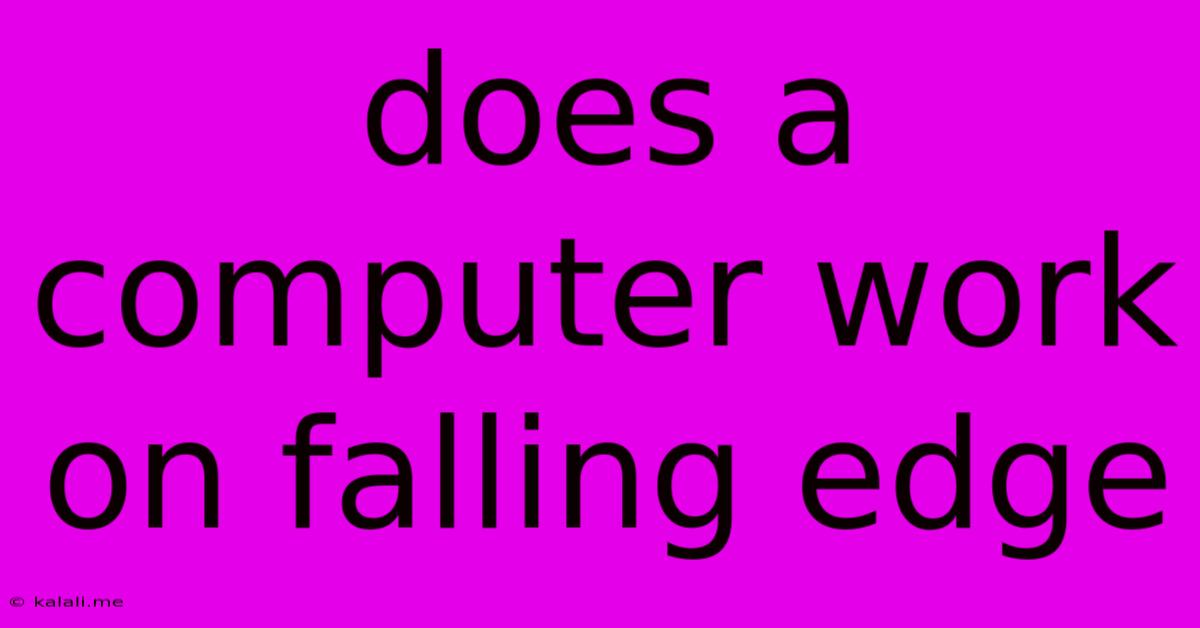Does A Computer Work On Falling Edge
Kalali
Jun 07, 2025 · 3 min read

Table of Contents
Does a Computer Work on a Falling Edge? Understanding Clock Signals and Data Transfer
The question of whether a computer works on a falling edge or a rising edge is a bit more nuanced than a simple yes or no. The short answer is: it depends on the specific design and component. While many modern computers predominantly use a particular edge, understanding both is crucial for grasping digital logic. This article will delve into the intricacies of clock signals, data transfer, and the role of rising and falling edges in computer operation.
What are Rising and Falling Edges?
Before diving into the specifics of computer architecture, let's clarify the terminology. A clock signal is a periodic electrical signal that synchronizes the operations within a digital circuit. It oscillates between a high voltage (logic 1 or HIGH) and a low voltage (logic 0 or LOW).
- Rising Edge: This refers to the transition of the clock signal from LOW to HIGH.
- Falling Edge: This refers to the transition from HIGH to LOW.
Many digital components, such as flip-flops and latches, are designed to trigger actions on either the rising edge, the falling edge, or even both.
The Role of Edges in Computer Operation
The choice of using a rising or falling edge for data transfer is largely a design decision. It affects how data is captured and processed within various components of a computer system. Consider these key aspects:
-
Flip-Flops and Latches: These fundamental building blocks of digital circuits store data. Some flip-flops are designed to latch data on the rising edge, meaning the stored value changes only when the clock signal transitions from LOW to HIGH. Others are designed to latch on the falling edge, changing only when the clock transitions from HIGH to LOW. This choice impacts the timing and synchronization of data within the system.
-
Memory Systems: Modern memory systems, such as RAM and ROM, utilize clock signals to control data access. The exact timing of data reads and writes is often dictated by specific edge triggering of control signals. While the internal workings might utilize both, the overall system interaction could appear to favor one edge.
-
Microprocessors: Microprocessors, the brains of computers, incorporate clock signals extensively. Different parts of the microprocessor might use rising or falling edges depending on their functionality. Instruction fetching, execution, and data transfer often involve carefully choreographed edge-triggered actions. While the overall operation might appear more complex, the underlying synchronization frequently relies on specific edge transitions.
-
Signal Integrity and Noise: In high-speed digital systems, the choice between rising and falling edges can be influenced by signal integrity concerns. One edge might be less susceptible to noise or interference than the other.
Why the Ambiguity?
The reason there's no single definitive answer to the question is because computer architecture is incredibly complex. Different parts of a computer system might use different edge triggering mechanisms. A single processor might have various subsystems that operate on different edges for optimization and efficient operation. It's more accurate to say that both rising and falling edges play significant roles within a computer, but the dominant edge might vary depending on the specific design.
In Conclusion
While some components might predominantly utilize a rising edge or a falling edge, the complete picture is far more intricate. Computers leverage both rising and falling edges strategically throughout their operation, optimized for speed, stability, and efficiency. Understanding the significance of clock signals and edge-triggered actions is crucial for grasping the fundamental workings of computer systems. The specific implementation details often remain complex and heavily dependent on the specific hardware and software involved.
Latest Posts
Latest Posts
-
How To Steam Tamales Without Steamer
Jun 07, 2025
-
Twitter Website Page Keep Resfreshing Cannot Sign In
Jun 07, 2025
-
Is It Hard To Knock Down Stone Walls Interior
Jun 07, 2025
-
Someone Called Me And Told Me My Check Routing Number
Jun 07, 2025
-
Bathroom Exhaust Fan Not Strong Enough
Jun 07, 2025
Related Post
Thank you for visiting our website which covers about Does A Computer Work On Falling Edge . We hope the information provided has been useful to you. Feel free to contact us if you have any questions or need further assistance. See you next time and don't miss to bookmark.